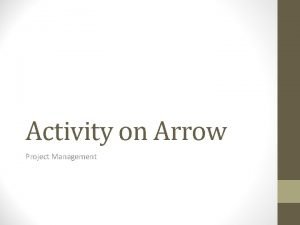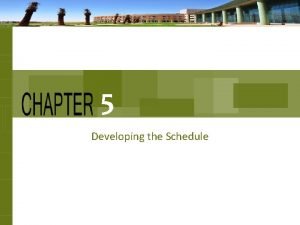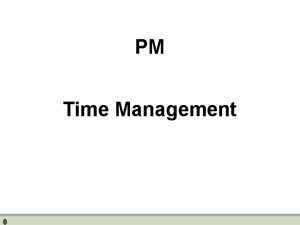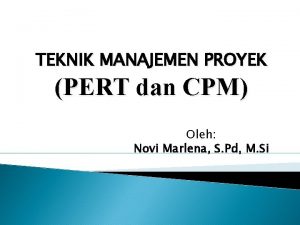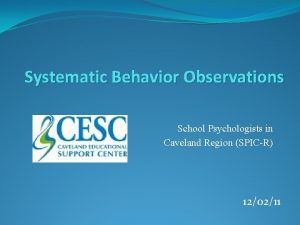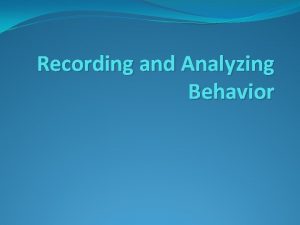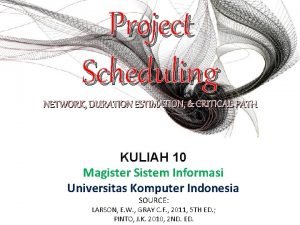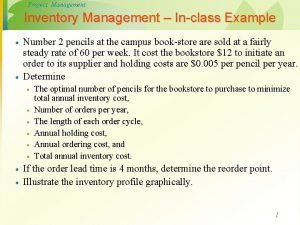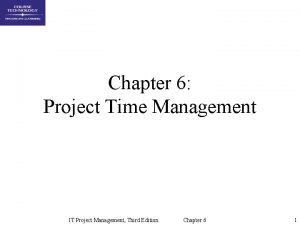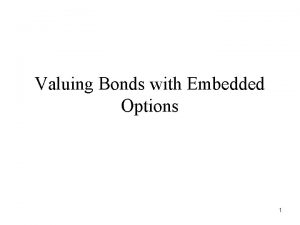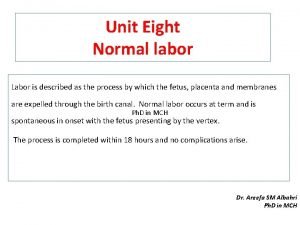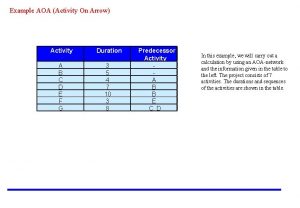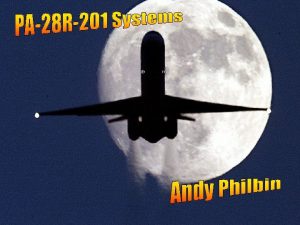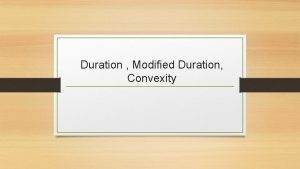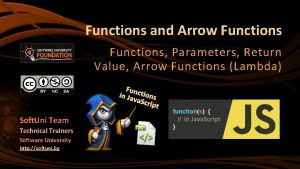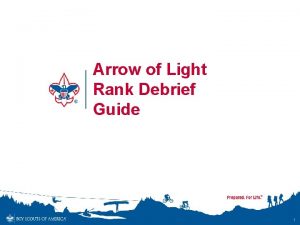Example AOA Activity On Arrow Activity Duration A















- Slides: 15

Example AOA (Activity On Arrow) Activity Duration A B C D E F G 3 5 4 7 10 3 8 Predecessor Activity A B B E C, D In this example we will carry out a calculation by using AOA-network, on the basis of information given in the table. The Project consists of 7 activities. Durations and sequences are shown in the table.

For each beingnode, able to westart havethe divided project, thewecircle should into upper haveand a start lovernode(event). halves. The upper half represents the activity number. 1 We have divided the lower part into halves as well. In the left half, we will write the earliest start and in the right half, the latest start that the activity can happen. Activity Duration A B C D E F G 3 5 4 7 10 3 8 Predecessor activity A B B E C, D Node nr. Earliest Time point Latest Time point

2 A (3) 1 5 C (4) G (8) D (7) 3 B (5) 6 E (10) F (3) 4 Activity Duration A B C D E F G 3 5 4 7 10 3 8 Predecessor activity A B B E C, D Accordingly it aisduration illustrated By using. Binformation Activity has in the of for table, five units we activities C, D, E, F and In. Inthis can draw and lies between a network. node Lines 1 G. and 3. the Both network, we out predecessor agiven calculation. network represent activities of Awill andcarry activities B have in the table. Theand activities durations begin from whichstart-node stand in the 1. table are given in the parenthesis in the network as well. Activity A which is shown between node 1 and 2, has a duration of 3 units.

2 A (3) 1 5 C (4) G (8) D (7) 3 B (5) 6 E (10) F (3) 4 Activity Duration A B C D E F G 3 5 4 7 10 3 8 In thecalculation The second step, is carried we go backwards out in two steps. final from Firstnode we go inforwards the network in the to the network. start node. In this step we will determine earliest start for all nodes. In this step we determine the latest time for each activity in the network. Predecessor activity A B B E C, D Node nr. Earliest Latest Time point

2 0+3=3 3 A (3) B (5) 0 5 3 6 E (10) 4 15 Activity Duration A B C D E F G 3 5 4 7 10 3 8 Activity We can reach Bhappens has Node(event) aactivity duration 4, 53. by soso passing the If event will duration 1 go onof with earliest forward AEofis at calculation time 0, the in The In our Duration project, of we activity have not is said 10 through activity event 3 happen becomes 5. ofbut event Therefore the network. 2 start can event not Thehappen 2 E. only can way before earliest end reaching at to anything earliest on startpoint for the event of the 4 for isproject 10 pluss activity 3. node 3 isstart A. to accomplish activity B. we will earliest calculate for event relatively 3 which andissay 5. this that the project gives 15 as starts the earliest at timestart 0. for event 4. G (8) D (7) 0+5=5 1 5 C (4) Predecessor activity A B B E C, D F (3) 5+10=15

3+4=7 2 C (4) 3 5+7=12 A (3) 1 G (8) 12+8=20 D (7) B (5) 0 5 12 5 3 6 20 E (10) 4 15 Activity Duration A B C D E F G 3 5 4 7 10 3 8 Predecessor activity A B B E C, D F (3) 15+3=18 Now we twoto different values We The If By passing going have same go have via two through, applies activity different the activity event Ctwo activity values, the 6 possibilities earliest where F we but G we gain both start we 15 But there was another way for reaching Forwe event 5, through there and should choose the largest of them. activities have for event pluss obtain two 312 , the should alternative 5 pluss becomes duration be which finished ways 3 ofpluss F, is that for the before the reaching duration becomes duration event 5. By going through activity reaching to: 8 via activity C or D. D, the Therefore the earliest start for activity event to 18. it: of activity G, via 5 soevent occurrence. activity the Cearliest equal F becomes or tostart Activity 4 that for gives event G. pluss 7. 6 earliest time five 6 the becomes 6. of activity D which is 7. So becomes 20. duration It results in the need to choose one of we will the earliest time of event 5 Now wehave determined all the two and we choose the larger value. so equal tostarts 12. for activities. earliest the earliest start for event 5 becomes 12.

2 C (4) 3 A (3) 1 G (8) D (7) B (5) 0 5 12 12 5 3 6 20 20 E (10) 4 15 17 Activity Duration A B C D E F G 3 5 4 7 10 3 8 20 -8=12 Predecessor activity A B B E C, D F (3) 20 -3=17 we calculate in 6 the The latest time for event 4 forbecomes For reaching event 4, to event gobeckwards from 5, a we event can just 5 Therefore thewe latest time event Wewill now carry out similar network. 20 minus 3 activity that 17. go through activity Fcaculating with a duration aealiest duration becomes 20 minus 8 Gequal to 12. of 3. process used forgives of 8. time but this timedate we will go Inevent thepoints case that a finish had been If 5 happens later than 12, event whole waylatest by determined for 20 thethe project, we start. would 6 bavkwards will not have as the subtracting insert this value in the right half of event 6. but no date is given so we assume that project should be finished as soon as possible. Therefore we say that the latest time for event 6 is equal to its earliest time and we set 20 as the latest time for that.

12 -4=8 8 -3=5 2 12 -7=5 3 8 A (3) 1 G (8) D (7) 3 B (5) 0 0 5 12 12 C (4) 6 20 20 5 5 5 -5=0 E (10) 17 -10=7 Activity Duration A B C D E F G 3 5 4 7 10 3 8 4 15 17 Predecessor activity A B B E C, D F (3) Westarting For can event reach 1 have we have event aofthe case 235 just by going two Again Event Initially But Then By we we 3 we should is we have slightly from goto values look from two event similar values, at event with and other to 4 with 0 and event and 57 and gain 55 through alternatives activity as well. C. lower By this event way we 2 we 17 minus alternative should subtracting and 6 when we choose should 10 as the we which well. the choose duration calculate We is. From the gain of value. forwardly. duration smaller activity 12 So minus of the gain have 12 8 we and minus the duration of activity offor Ctime Theduration activity the earliest B(5), value. latest time E. gain time This of for the activity for gives event latest event the 3 D time is 3 latest equal 5. should to event be 7 A which 3, soisisbetween we 4. 5. gain This results we in need a latest to chosen of that 1 is that 7 gives for event equal 3. to 5. two 0. butalternatives time look equal at other to alternative 8 are fortwo event as 2. well. because there acctivities branching from event 3.

Now we have out calculations From network, we that activity A Firstcan We Both Activity Similarly, we activity extract list C F will Activity has all calculate Dcarried event activities the andsee earliest GE 42 has have as as thein its the earliest start anode startevent column of 3 node. all as 5 of all of project nodes. we will now and Bof have event 1 ititsas their start in extreme start activities their event. Therefore as start-event start Therefore allby node the left. looking and earliest activities. where Inthe gives earliest at adjacent start the earliest This earliest 12 for start as value activity start the for start isof look calculation of event, the earliest timestart) iswe 0. In column, demonstrated start-node is activity F earliest becomes 5. atwhere start Cthe becomes of 15. respective for each byactivity ES(earliest activity. 3. activities durations G. are will dowords, this thestart table. other the time for. A has a shown. For in example activity activities A 3. and B is 0. duration of Activity Duration ES EF LS LF FL A 3 0 3 5 8 5 B 5 0 5 0 C 4 3 7 8 12 5 D 7 5 12 0 E 10 5 15 7 17 2 F 3 15 18 17 20 2 G 8 12 20 0

Nowactivity For Calculations Activity finding we C will has this Aof B, calculate we the EF all value gain is event remaining equal for the 0 2 plus each as earliest to its 53 pluss that start time activity, gives activities 0 event thatpoints an therefore gives we EF areat 5 take equal carried which the toearliest out activities 3. similarly. start time can for ofend. These its activity starttime event C becomes points and add are 3. supplied to the duration in the column of that activity. under EF(Earliest In other words Finish) since the earliest start of activities is equal to earliest time of its start event, we can find EF by aggregating ES and the duration of activity. Activity Duration ES EF LS LF FL A 3 0 3 5 8 5 B 5 0 5 0 C 4 3 7 8 12 5 D 7 5 12 0 E 10 5 15 7 17 2 F 3 15 18 17 20 2 G 8 12 20 0 EFi=ESi+ti

We can this value directly Activities Now Activity Event For activity we 5 find is. A have Fthe has E, B, and final accomplished event G have event 432 is with asevent the for itslatest the final both 6 from asstart the diagram as well. Thelatest calculation event activities of their 5 network isend-event and the. Cthe final of and latest earliest so event. D the and time finish start latest So this that the becomes and gives finish the latest for 17. latest time that activity can 5. finish earliest event finish both activities 2 for offinish can 12 activity happen forfor isan both equal all B isbecomes activities. 8. to. Therefore 20. From the is same as time of 8. the endnow latest on finish wethe will of latest Alook becomes at latest start and event that First activity. finish of times. we look at latest finish(LF). Activity Duration ES EF LS LF FL A 3 0 3 5 8 5 B 5 0 5 0 C 4 3 7 8 12 5 D 7 5 12 0 E 10 5 15 7 17 2 F 3 15 18 17 20 2 G 8 12 20 0

Nowremaining For The Activity activity latest it remains Bstart has A itactivities, afor isto becomes latest the calculate activity latest finish same 8 C finish minus the equal becomes latest 3 to start minus 58 equal calculations and or of 12 to athe each duration minus 5. duration 8 are activity. is 4. the carried oflatest of 5. In This each out the finish gives as activity. table and ait 3 is demonstrated is latest illustrated the start duration in of the 0. by oftable. LS(latest activity. start) Activity Duration ES EF LS LF FL A 3 0 3 5 8 5 B 5 0 5 0 C 4 3 7 8 12 5 D 7 5 12 0 E 10 5 15 7 17 2 F 3 15 18 17 20 2 G 8 12 20 0 LSi=LFi-ti

Activity Duration ES EF LS LF FL A 3 0 3 5 8 5 B 5 0 5 0 C 4 3 7 8 12 5 D 7 5 12 0 E 10 5 15 7 17 2 F 3 15 18 17 20 2 G 8 12 20 0 We Now Which In our can we case, activities determine have thecalculated FL(Float) influence this bysufficiently looking isinequal this end atto the in order date? LF float minus of to. ES different know minus when activities. In theearliest duration and of order latesttotimes activity calculate 1. of each float event of each occurs. We Which activities have importance for activity, also know we when take the each latest activity time can of its determining the end date. end-node start and finish subtract at earliest fromand that the earliest latest. we time have of its found start-node. out that Now the we project have becomes the total period accomplished in whichinthe 20 activity days. will be carried out. From this value, we subtract duration of same activity. The remaining value is called float. The float is the surplus time and represents the amount that activities have freedom for planning. Fli =LFi-Esi -ti =LFi-(Esi +ti) =LFi-Efi Fli =(LFi-ti)-ESi =LSi-ESi

Nowactivity Activity For Similarly we C have ithas is A carried B, two LF athe float isequivalent float equal out ofis 5, for 5 towhen minus 8 theminus LF 5=0. EF 12 equal is remaining formulas and for to EF activities. 3 calculation isthat 7. gives aoffloat the float. of 5. In this example We use LF minus EF. Activity Duration ES EF LS LF FL A 3 0 3 5 8 5 B 5 0 5 0 C 4 3 7 8 12 5 D 7 5 12 0 E 10 5 15 7 17 2 F 3 15 18 17 20 2 G 8 12 20 0 Fli =LFi-Esi -ti =LFi-(Esi +ti) =LFi-Efi Fli =(LFi-ti)-ESi =LSi-ESi

2 5 12 12 C (4) 3 8 A (3) 1 3 B (5) 0 0 G (8) D (7) 6 20 20 5 5 E (10) F (3) 4 15 17 Activity Duration ES EF LS LF FL A 3 0 3 5 8 5 B 5 0 5 0 C 4 3 7 8 12 5 D 7 5 12 0 E 10 5 15 7 17 2 F 3 15 18 17 20 2 G 8 12 20 0 Some Activities of activities B, D, andthe have Gfloat which float all ofwe zero. have Pay attention that are float It means of zero that are there critical is no activities. freedom in speaking about belongs to whole chain planning of such. For activities, other E in the network. instanceinactivities We can draw a continous chain of words they not be extended. and F lie in can a chain between event. We 3 and critical activities from first event to call this both type have of activities, 6. They a float ofcritical 2 days; but the last event. This chain includes activities. contrast, activities we can not. Insimultanously use 2 with days activities B, D and G and we call it positive possibility be float for float each have of them. In otherto words critical path. extended thehave finisha these two without activitiesaffecting altogether date float of of network. two days. 2 days for E, 2 days for F or 1 day for each of them. The same applies to the chain in which A and C lie. In this case these two, altogether share a float of five days.
 Aoa examples
Aoa examples Aoa and aon
Aoa and aon Activities on arrow
Activities on arrow The estimated duration for each activity must be the
The estimated duration for each activity must be the Activity duration estimating
Activity duration estimating Activity on arrow
Activity on arrow Duration recording data sheet example
Duration recording data sheet example Frequency recording example
Frequency recording example What is a nonserual sequential logic in project
What is a nonserual sequential logic in project Project management notes for ese
Project management notes for ese Gantt chart for inventory management system
Gantt chart for inventory management system Gant chart software
Gant chart software Most projects have one path through a network diagram
Most projects have one path through a network diagram Valuing bonds with embedded options
Valuing bonds with embedded options Contractions
Contractions Sat test length
Sat test length


